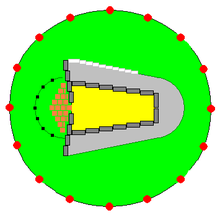Wedge tombs on Lough Gur
The Wedge Tombs on Lough Gur are east of Holycross and north of Bruff in County Limerick , Ireland . Wedge Tombs ( German "wedge tombs" ), formerly "wedge-shaped gallery grave" called, are double-walled, seamless, mostly unarticulated megalithic of the late Neolithic and early Bronze Age .
The larger wedge tomb
The larger Wedge Tomb marked on the OS maps as Giant's Grave ( German "Riesengrab" ) is located near the south-east bank of Lough Gur ( Irish Loch Goir ) on a gentle slope ( 52 ° 30 ′ 45.5 ″ N , 8 ° 31 ′ 23.4 ″ W ). The north-east-south-west oriented Wedge Tomb consists of four lateral bearing stones and three overlying cap stones and, along with Labbacallee, is one of the largest in Ireland. The fourth capstone is relocated and blocks access to the chamber. The double outer wall on both sides is better preserved on the southeast side. The back wall of the chamber has a small end stone. Two upright orthostats stand on either side of the entrance as part of the facade. The main chamber and the small antechamber (antechamber) are together about 8.0 m long and were covered by a small stone mound in the typical wedge shape until the 19th century, the outline of which is still visible.
The Wedge Tomb was excavated in 1938. The archaeologists found the bones of at least eight adults and four children, along with corpses and cup-type pottery shards and some flint debris . The facility was built in the early Bronze Age , around 2500 BC. Dated.
The smaller wedge tomb
The smaller, badly damaged Wedge Tomb of Ballynagallagh, marked on the OS maps as Leaba na Muice ( German "Bett des Schweins" ) is located near the south bank of Lough Gur on a slight slope, about 750 m west of the larger one Area known as "The Red Bog" ( 52 ° 30 ′ 30.5 ″ N , 8 ° 31 ′ 55.3 ″ W ). The northeast-southwest oriented Wedge Tomb consists only of an upright side stone in the northwest, the end stone in the southwest and an overlying cap stone.

